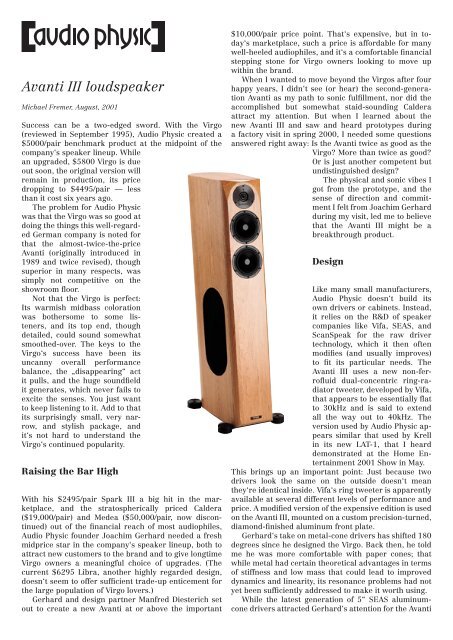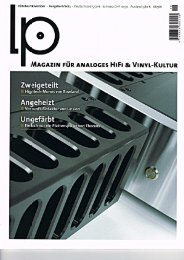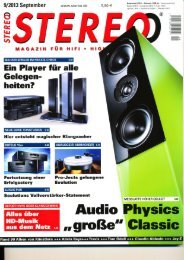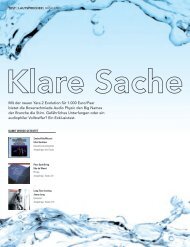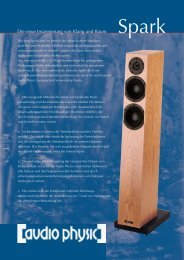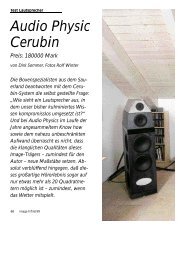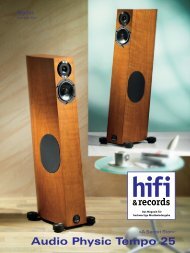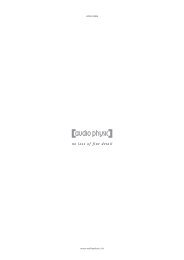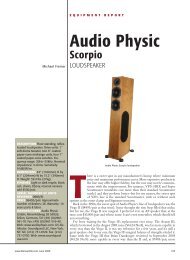Avanti III loudspeaker - Audio Physic
Avanti III loudspeaker - Audio Physic
Avanti III loudspeaker - Audio Physic
You also want an ePaper? Increase the reach of your titles
YUMPU automatically turns print PDFs into web optimized ePapers that Google loves.
<strong>Avanti</strong> <strong>III</strong> <strong>loudspeaker</strong><br />
Michael Fremer, August, 2001<br />
Success can be a two-edged sword. With the Virgo<br />
(reviewed in September 1995), <strong>Audio</strong> <strong>Physic</strong> created a<br />
$5000/pair benchmark product at the midpoint of the<br />
company‘s speaker lineup. While<br />
an upgraded, $5800 Virgo is due<br />
out soon, the original version will<br />
remain in production, its price<br />
dropping to $4495/pair — less<br />
than it cost six years ago.<br />
The problem for <strong>Audio</strong> <strong>Physic</strong><br />
was that the Virgo was so good at<br />
doing the things this well-regarded<br />
German company is noted for<br />
that the almost-twice-the-price<br />
<strong>Avanti</strong> (originally introduced in<br />
1989 and twice revised), though<br />
superior in many respects, was<br />
simply not competitive on the<br />
showroom floor.<br />
Not that the Virgo is perfect:<br />
Its warmish midbass coloration<br />
was bothersome to some listeners,<br />
and its top end, though<br />
detailed, could sound somewhat<br />
smoothed-over. The keys to the<br />
Virgo‘s success have been its<br />
uncanny overall performance<br />
balance, the „disappearing“ act<br />
it pulls, and the huge soundfield<br />
it generates, which never fails to<br />
excite the senses. You just want<br />
to keep listening to it. Add to that<br />
its surprisingly small, very narrow,<br />
and stylish package, and<br />
it‘s not hard to understand the<br />
Virgo‘s continued popularity.<br />
Raising the Bar High<br />
With his $2495/pair Spark <strong>III</strong> a big hit in the marketplace,<br />
and the stratospherically priced Caldera<br />
($19,000/pair) and Medea ($50,000/pair, now discontinued)<br />
out of the financial reach of most audiophiles,<br />
<strong>Audio</strong> <strong>Physic</strong> founder Joachim Gerhard needed a fresh<br />
midprice star in the company‘s speaker lineup, both to<br />
attract new customers to the brand and to give longtime<br />
Virgo owners a meaningful choice of upgrades. (The<br />
current $6295 Libra, another highly regarded design,<br />
doesn‘t seem to offer sufficient trade-up enticement for<br />
the large population of Virgo lovers.)<br />
Gerhard and design partner Manfred Diesterich set<br />
out to create a new <strong>Avanti</strong> at or above the important<br />
$10,000/pair price point. That‘s expensive, but in today‘s<br />
marketplace, such a price is affordable for many<br />
well-heeled audiophiles, and it‘s a comfortable financial<br />
stepping stone for Virgo owners looking to move up<br />
within the brand.<br />
When I wanted to move beyond the Virgos after four<br />
happy years, I didn‘t see (or hear) the second-generation<br />
<strong>Avanti</strong> as my path to sonic fulfillment, nor did the<br />
accomplished but somewhat staid-sounding Caldera<br />
attract my attention. But when I learned about the<br />
new <strong>Avanti</strong> <strong>III</strong> and saw and heard prototypes during<br />
a factory visit in spring 2000, I needed some questions<br />
answered right away: Is the <strong>Avanti</strong> twice as good as the<br />
Virgo? More than twice as good?<br />
Or is just another competent but<br />
undistinguished design?<br />
The physical and sonic vibes I<br />
got from the prototype, and the<br />
sense of direction and commitment<br />
I felt from Joachim Gerhard<br />
during my visit, led me to believe<br />
that the <strong>Avanti</strong> <strong>III</strong> might be a<br />
breakthrough product.<br />
Design<br />
Like many small manufacturers,<br />
<strong>Audio</strong> <strong>Physic</strong> doesn‘t build its<br />
own drivers or cabinets. Instead,<br />
it relies on the R&D of speaker<br />
companies like Vifa, SEAS, and<br />
ScanSpeak for the raw driver<br />
technology, which it then often<br />
modifies (and usually improves)<br />
to fit its particular needs. The<br />
<strong>Avanti</strong> <strong>III</strong> uses a new non-ferrofluid<br />
dual-concentric ring-radiator<br />
tweeter, developed by Vifa,<br />
that appears to be essentially flat<br />
to 30kHz and is said to extend<br />
all the way out to 40kHz. The<br />
version used by <strong>Audio</strong> <strong>Physic</strong> appears<br />
similar that used by Krell<br />
in its new LAT-1, that I heard<br />
demonstrated at the Home Entertainment<br />
2001 Show in May.<br />
This brings up an important point: Just because two<br />
drivers look the same on the outside doesn‘t mean<br />
they‘re identical inside. Vifa‘s ring tweeter is apparently<br />
available at several different levels of performance and<br />
price. A modified version of the expensive edition is used<br />
on the <strong>Avanti</strong> <strong>III</strong>, mounted on a custom precision-turned,<br />
diamond-finished aluminum front plate.<br />
Gerhard‘s take on metal-cone drivers has shifted 180<br />
degrees since he designed the Virgo. Back then, he told<br />
me he was more comfortable with paper cones; that<br />
while metal had certain theoretical advantages in terms<br />
of stiffness and low mass that could lead to improved<br />
dynamics and linearity, its resonance problems had not<br />
yet been sufficiently addressed to make it worth using.<br />
While the latest generation of 5“ SEAS aluminumcone<br />
drivers attracted Gerhard‘s attention for the <strong>Avanti</strong>
<strong>III</strong>‘s midrange, resonances at the top of the frequency<br />
range made such drivers unacceptable — until the design<br />
duo of Gerhard and Diesterich began to apply various<br />
materials at different tensions to the cone‘s underside<br />
circumference, where it attaches to the surround.<br />
During my visit to the <strong>Audio</strong> <strong>Physic</strong> factory, I watched<br />
and listened as various materials, including plain old<br />
rubber bands, were applied to the cones. The results<br />
were dramatic — even when the raw driver, sitting on<br />
a test bench, was driven by a portable transistor radio.<br />
Unmodified, the driver had a characteristic „pinging“<br />
sound. Modification in place, the „ping“ was gone.<br />
Ultimately, AP developed a material and an application<br />
methodology, Active Cone Damping (ACD), that<br />
SEAS now incorporates in its manufacturing process<br />
— but only for drivers destined for <strong>Audio</strong> <strong>Physic</strong>. The<br />
midrange driver used in the <strong>Avanti</strong> <strong>III</strong> is a heavily modified<br />
version of SEAS‘s original design.<br />
The <strong>Avanti</strong> <strong>III</strong> uses two pairs of side-mounted, dualported,<br />
floor-firing 61⁄2“ Peerless woofers (for a total of<br />
four woofer per speaker) in push/push configuration, as<br />
originally introduced on the first <strong>Avanti</strong>. Side mounting<br />
allows for a narrow, graceful front baffle, and AP claims<br />
the driver placement helps equalize pressure on the<br />
cabinet walls for lower distortion and better dynamic<br />
performance.<br />
The crossover points are 200Hz (6dB/octave), 500Hz<br />
(6dB/octave), and 2.2kHz (18dB/octave). Why three<br />
points? Because the amount of radiating surface required<br />
increases as the frequency decreases. The dual<br />
midrange drivers are not there to double the midrange<br />
energy. The design uses the lower-midrange driver only<br />
in the narrow band between 200 and 500Hz, while the<br />
more powerful upper-midrange unit, fitted with dual<br />
magnet assemblies, covers 200-2200Hz. The radiating<br />
area is thus increased in the lower midrange without<br />
encumbering the rest of the response range with unnecessary<br />
mass.<br />
The compact, curvaceous cabinet, sourced from<br />
a Danish company that builds enclosures for many<br />
big-name speaker companies (some of which make<br />
their own drivers), is both aesthetically pleasing and<br />
technologically advanced. It‘s surprisingly light, yet extremely<br />
rigid and well-damped. The midrange drivers<br />
and tweeter occupy isolated chambers within the raked<br />
cabinet, which is extensively braced and rounded at<br />
the rear to avoid the parallel surfaces that can induce<br />
standing waves. A slanted (7 degrees), dual-layer baffle<br />
features a front panel of solid, laminated wood specially<br />
contoured to minimize diffraction and refraction. This<br />
panel‘s complex design is the result of the patented<br />
Hornflex process, which uses a computer program to<br />
transfer the three-dimensional shapes onto the twodimensional<br />
patterns used in the actual manufacturing<br />
process. The speaker‘s rear is fitted with a single pair<br />
of gold-plated binding posts. A biamping option of dual<br />
pairs of posts is available at extra cost.<br />
Setup<br />
Contrary to a popular misconception, <strong>Audio</strong> <strong>Physic</strong><br />
speakers are not specifically designed for nearfield<br />
placement and listening, though the setup procedure<br />
outlined on Immedia‘s website is recommended, and<br />
works well for other <strong>loudspeaker</strong> brands as well.<br />
Though I listen in the nearfield because of how my room<br />
is configured, I was unable to set up the <strong>Avanti</strong> <strong>III</strong>s using<br />
<strong>Audio</strong> <strong>Physic</strong>‘s methodology. Instead, I placed the<br />
<strong>Avanti</strong>s where the Sonus Faber Amati Homages usually<br />
reside (9‘ apart, 8‘ from the listening position, 21⁄2‘ from<br />
the sidewalls, and about 21⁄2‘ from the front wall), then<br />
moved them slightly forward to account for the acoustic<br />
center of the side-mounted woofers. I ended up with the<br />
speakers toed-in so that the tweeter axes crossed just<br />
behind my head.<br />
As with the Virgo or any other revealing speaker, setup<br />
of the <strong>Avanti</strong> <strong>III</strong>s proved critical in maximizing highperformance<br />
results. Tiny changes in placement yielded<br />
enormous sonic differences, especially when it came to<br />
locking in the incredible image focus and soundstaging<br />
precision these speakers were capable of delivering. Of<br />
course, you never know how well a pair of speakers can<br />
perform until you try to improve on what you‘ve already<br />
achieved. Sometimes you‘ve already reached the upper<br />
limit of a product‘s performance capabilities and<br />
are wasting your time. In the case of the <strong>Avanti</strong> <strong>III</strong>s, I<br />
thought I‘d maxed them out only to find that I could take<br />
them a step further. I also found that the speakers were<br />
ruthlessly revealing of a cartridge‘s vertical tracking angle<br />
(VTA) and other minutiae of analog setup.<br />
The narrow <strong>Avanti</strong> <strong>III</strong> sits on a pair of metal stabilizer<br />
cross-braces with circular feet at each end. Port clearance<br />
seemed insufficient on my Berber-carpeted floor<br />
using the short threaded points supplied, so I asked and<br />
quickly received a longer set. It‘s a cultural issue: Apparently,<br />
Europeans mostly have area rugs and set the<br />
speakers on hardwood floors, which is why AP also supplies<br />
tiny, cupped, felt-bottomed feet.<br />
Listening<br />
I ended up having the <strong>Avanti</strong> <strong>III</strong>s for two extended<br />
periods of time, before and after HE 2001. After three<br />
weeks of extensive listening, I had to ship them to New<br />
York City, where they were used in one of the Sound By<br />
Singer rooms at the Show, driven by Hovland electronics,<br />
an Accuphase CD player, and an Immedia RPM-1<br />
turntable with RPM-2 tonearm and Helikon cartridge.<br />
Aside from the amplifier, turntable, CD player, and<br />
cables, Show attendees got to hear a reasonably close<br />
approximation of my review system, including electronics,<br />
tonearm, and cartridge. If you heard AP‘s system at<br />
HE2001, you got a taste of what I‘ve been hearing for<br />
well over a month. Yummy.<br />
I got to spend the first day after the Show at home<br />
with the new Hovland Sapphire tube amp. Even under<br />
lousy Show conditions, that system had sounded very<br />
musical to my ears. At home in my acoustically tweaked<br />
room, the <strong>Avanti</strong> <strong>III</strong>s, driven by all-Hovland electronics,<br />
sounded even more impressive. I spent the rest of the<br />
month with the <strong>Avanti</strong> <strong>III</strong>s driven by my reference Musical<br />
Fidelity Nu-Vista 300 power amplifier.<br />
When I‘d parted company with the Virgos, I‘d willingly<br />
given up some of their astounding imaging and
soundstaging prowess to get the Sonus Faber Amatis‘<br />
rich, voluptuous, swoon-inducing delicacy and inner detail.<br />
I‘d traded brisk athleticism and excitement for raw,<br />
seductive sex. The <strong>Avanti</strong> <strong>III</strong> delivered all that I‘d given<br />
up and more, with surprising ease — in fact, without<br />
ever pausing for a breath.<br />
If cleanliness is next to godliness, the <strong>Avanti</strong>s were<br />
next to godlike — so clean, so detailed, so revealing —<br />
and yet, when everything (including the source material)<br />
was right, so rich, so fundamentally correct and satisfying.<br />
Take Willie Nelson‘s „Stardust,“ from the album of<br />
the same name (Columbia JC 35305 or Classic Records‘<br />
180gm vinyl reissue): The <strong>Avanti</strong> <strong>III</strong>s delivered the track<br />
with each element neatly separated yet seemingly connected<br />
to a delicate whole. Nelson‘s voice was out front,<br />
compact and hovering vividly in three dimensions. His<br />
chest was present, but without „chestiness.“ As Nelson<br />
varied the volume of his voice within the phrasing, he<br />
seemed to pitch slightly forward and back. There was<br />
no „overhang“ to the voice. It was there in bold relief,<br />
with nothing but black beyond, all the way to the drum<br />
kit. The drums, crisply rendered but not overcooked,<br />
were punctuated by woody rimshots, the pop of each of<br />
which was followed by a gentle trail-off. The cleanliness<br />
of the brush and cymbal work was memorable. Booker<br />
T‘s juicy-toned organ hovered in the distance, and the<br />
closely miked acoustic guitar picked the melody smartly<br />
in midfield. Each cleanly delineated musical development<br />
had a consequence that the ear could follow, even<br />
as new events piled on in rapid succession.<br />
Within this simple, spacious arrangement was a wide<br />
variety of tones, textures, and, especially, events. The<br />
<strong>Avanti</strong> delivered each the way a cold, clear night delivers<br />
the stars. But don‘t think I‘m implying that the <strong>Avanti</strong><br />
sounded cold. Hardly. With clarity and focus comes<br />
an inviting, almost warming certainty. Along with its superb<br />
clarity, the other standout quality of the <strong>Avanti</strong> that<br />
remains with me was its top-to-bottom rhythmic coherence.<br />
Its ultrafast, ultradetailed top end was matched by<br />
its tight, nimble, well-damped midbass and bass. Where<br />
the Virgo is warm and somewhat hung-over in the bass,<br />
the <strong>Avanti</strong> was lean and muscular — which is not the<br />
same as „thin.“ The Hovland preamp brought a new<br />
level of microdynamic bass control to my system. The<br />
<strong>Avanti</strong> <strong>III</strong> brought that subtle, rolling sensation of ultralow-level<br />
bass articulation and control to new heights of<br />
delicacy and detail.<br />
The <strong>Avanti</strong> <strong>III</strong>s disappeared even more effectively<br />
than did the Virgos; having not lived with that sensation<br />
for two years (at least not to the same degree), I spent<br />
many, many late nights catching up on it. The <strong>Avanti</strong><br />
<strong>III</strong>s managed to delineate and differentiate the positions<br />
of lateral images with even greater precision than the<br />
Virgos had (as I remembered them playing very familiar<br />
recordings), while rendering those images in greater<br />
relief against blacker, clearer backgrounds.<br />
I played the original UK LP edition of the Beatles‘ Abbey<br />
Road straight through one night at relatively high<br />
SPLs and was enthralled by the speakers‘ ability to let<br />
me follow each Beatle‘s vocal line with ease, though<br />
they‘re mixed together spatially. The distinctive vocal<br />
timbres seemed to hold together with greater authority<br />
than I remembered ever hearing, and I noted that<br />
Ringo‘s drums were rendered unusually cleanly, with-<br />
out compression or edginess. Top-end extension was<br />
satisfyingly open and airy, without etch, and without<br />
the highs pulling apart from the musical mix — though<br />
when recordings had been artificially and unpleasantly<br />
brightened, there was no escaping it in the playback<br />
through the <strong>Avanti</strong> <strong>III</strong>s.<br />
If you‘re getting the idea that I really loved the <strong>Avanti</strong><br />
<strong>III</strong>, you‘re correct. It offered superb dynamics at both<br />
ends of the scale and never sounded compressed, even<br />
when played at ultra-high SPLs. Its tonal coloration was<br />
impressively low. In fact, aside from a slight but very<br />
noticeable leanness in the midbass that seemed to drop<br />
off a few dBs over the entire range (and could have been<br />
a room-related issue), the <strong>Avanti</strong> ranks with the Infinity<br />
Prelude MTS as, subjectively, the least-colored speaker<br />
I‘ve reviewed.<br />
One-third-octave tones on Alan Parsons‘ Sound<br />
Check CD (Mobile Fidelity SPCD-15) indicated a speaker<br />
with a superbly flat in-room response, and I‘ve never<br />
heard sweep tones reproduced with such evenness. This<br />
speaker should produce a super-clean waterfall curve;<br />
its off-axis response seemed to be free of sonic bumps<br />
and bruises, making side-chair listening a pleasure. I<br />
know — I often had to give up the sweet spot!<br />
The <strong>Avanti</strong> bettered the Infinity Prelude in the midrange,<br />
however, being somewhat more revealing and<br />
delicate, and definitely more detailed and less congested.<br />
Female vocals, for example, had a clarity and focus<br />
that easily surpassed what I remembered the Prelude<br />
delivering. But the Infinity, with its built-in powered 12“<br />
subwoofer, stomped all over the <strong>Avanti</strong> in the deep-bass<br />
department. Though the <strong>Avanti</strong> <strong>III</strong> is rated at 28Hz-<br />
40kHz, -3dB, in my room its response at 25Hz was audible<br />
but minimal, and 30Hz was only somewhat better.<br />
Because of its audibly flat and extended HF response<br />
and seemingly lean midbass, the <strong>Avanti</strong> <strong>III</strong> could sometimes<br />
sound somewhat thin overall — even, some might<br />
say, „analytical“ — especially if you‘re used to or crave<br />
whomp-‘em stomp-‘em room-warming bass and midbass.<br />
Certainly the <strong>Avanti</strong> <strong>III</strong>‘s overall character wasn‘t as<br />
„rich“ as, for example, the Amati Homage‘s. The lack of<br />
midbass warmth could also contribute to the sensation<br />
that the speaker couldn‘t fill a moderately large room. In<br />
fact, it‘s recommended for rooms of 210-460ft2 with ceilings<br />
of average height. My review pair had no problem<br />
filling my moderately sized, 15‘ by 21‘ (315ft) space.<br />
There‘s a solution to the bottom-end problem: Add<br />
a subwoofer. There are two new subwoofers coming<br />
from <strong>Audio</strong> <strong>Physic</strong>, but they weren‘t available for this<br />
review; I used the older AP Rhea. The <strong>Avanti</strong> <strong>III</strong>‘s clean<br />
and subjectively flat low-end response, which sounded<br />
as if it rolled off evenly below 40Hz, meant that dialing-in<br />
the subwoofer without overlap was not difficult.<br />
The result was bottom-octave extension without midbass<br />
muddiness.<br />
I hear you: „$11,000 and I still need a subwoofer?“<br />
Well, you don‘t need a subwoofer with the <strong>Avanti</strong> <strong>III</strong>.<br />
There was plenty of satisfying, well-defined, nonmechanical<br />
deep bass, but not of the stomach-socking sort.<br />
The bass definition I got was of the „six-pack stomach<br />
variety“: tight and exceptionally well-defined. Bass of<br />
the stomach-socking variety will require a subwoofer.<br />
So will reproduction of the biggest organ pipes.
But if your main concern is with the <strong>Avanti</strong> <strong>III</strong>‘s<br />
rhythmic talents, don‘t worry about a subwoofer. The<br />
speaker‘s abilities to swing, carry a beat, and communicate<br />
rhythm and pacing were absolutely first-class. In<br />
that regard, the <strong>Avanti</strong> <strong>III</strong> beat the Infinity Prelude, the<br />
Virgo, and the Amati Homage, which rhythmically delivers<br />
a mature and satisfyingly wet kiss compared to the<br />
<strong>Avanti</strong>‘s muscular teenaged tongue.<br />
High clarity, ultra-low distortion, accurate timbral<br />
and rhythmic presentation, breathtaking soundstaging<br />
(width, depth, and height), three-dimensional imaging,<br />
natural focus without hyper edge-definition — you<br />
should hear all of these attributes and many others if<br />
you audition the <strong>Avanti</strong> <strong>III</strong>s in a well-set-up demo. But<br />
most important, the <strong>Avanti</strong> <strong>III</strong> delivered music with<br />
ease. And despite their analytical honesty, and unlike<br />
some other analytical speakers, they did so without imparting<br />
a medicinal aftertaste.<br />
Comparing an original UK Island pressing of John<br />
Martyn‘s exceptionally fine Solid Air (Island ILPS 9226)<br />
with the recent Simply Vinyl reissue revealed subtle but<br />
striking differences: By itself, the SV reissue sounded<br />
like an outstanding recording. The original, however,<br />
put holographic, 3-D Martyn in a space — my room<br />
— and made the reissue sound cardboard-cutout twodimensional<br />
by comparison. This difference was audible<br />
through the Amati Homages, but not with the same<br />
stark, vivid clarity.<br />
Listening to the <strong>Avanti</strong> <strong>III</strong>s late into night after night,<br />
I experienced new insight into the physical and emotional<br />
underpinnings of some of my favorite recordings.<br />
The mental nourishment was accompanied by waves of<br />
sheer, sensual sonic pleasure. How much more do you<br />
expect a <strong>loudspeaker</strong> to communicate?<br />
Conclusion<br />
Rather than beat you over the head with a play-byplay<br />
of what my usual reference recordings sounded like<br />
through the <strong>Avanti</strong> <strong>III</strong>, I‘ve tried to convey the big, generalized<br />
picture. Like the Infinity Prelude, the <strong>Avanti</strong> <strong>III</strong><br />
proved that it‘s possible to design a flat-response <strong>loudspeaker</strong><br />
that does not sound antiseptic, bright, or hard<br />
— one that still manages to communicate the meaning<br />
and mystery of music while presenting a vivid, accurate,<br />
and detailed picture of what has been recorded or what<br />
is being reproduced. VTA set too high? You‘ll know it.<br />
Truly flat response should open up the timbral palette,<br />
not create a cold, sterile, monochromatic musical<br />
world. The <strong>Avanti</strong> <strong>III</strong> proved that. It easily delineated<br />
the delicate individual instrumental colors within an<br />
orchestra‘s massed strings, for example, while preserving<br />
the coherence of the whole. The difference between<br />
spurious „detail“ created by response peaks and<br />
genuine detail created by flat response was made clear<br />
by the <strong>Avanti</strong> <strong>III</strong>‘s performance in the mid- to high-frequency<br />
range.<br />
Though not particularly large speakers, the <strong>Avanti</strong><br />
<strong>III</strong>s produced a very large, airy sonic picture while<br />
managing to „disappear“ from sight, even when I stared<br />
at them. Not since I owned the Virgos have so many<br />
newcomers sat in the sweet spot to listen, only to say,<br />
„Where‘s the music coming from?“ — or to point to<br />
the amplifier between them and say, „Is it coming from<br />
there?“<br />
<strong>Audio</strong> <strong>Physic</strong> speakers are noted for their holographic<br />
imaging and superb three-dimensional soundstaging.<br />
No one will be disappointed by the <strong>Avanti</strong> <strong>III</strong>s‘ spatial<br />
performance, which is not only exceptional but among<br />
the very best I‘ve heard. I stared them down with the<br />
lights on and they still managed to exit the building,<br />
leaving me in the presence of a musical event that asserted<br />
itself with uncommon ease.<br />
The <strong>Avanti</strong> <strong>III</strong> proved to be a low-coloration, lowdistortion,<br />
high-performance speaker free of glaring<br />
tonal glitches or rhythmic discontinuities. While, like<br />
the Virgo, it brought a great number of strengths to the<br />
table, it was the <strong>Avanti</strong>‘s overall balance that impressed<br />
and kept me coming back for more, night after night.<br />
Aside from a slight leanness in the midbass, that missing<br />
bottom octave, and poorly designed gold-plated bindingpost<br />
knobs that feature finger-shredding, pain-inducing<br />
ridges, the <strong>Audio</strong> <strong>Physic</strong> <strong>Avanti</strong> <strong>III</strong> is a superb-sounding<br />
<strong>loudspeaker</strong> that I‘m betting will measure as impressively<br />
as it sounds.<br />
I periodically begin to think I‘ve stripped all of the<br />
hidden detail from the pits or grooves of my favorite<br />
recordings, but then along comes a component like the<br />
<strong>Avanti</strong> <strong>III</strong> to reveal new details and, more important,<br />
fresh musical insights.<br />
Longtime Virgo owners waiting for something meaningful<br />
to move up to within the <strong>Audio</strong> <strong>Physic</strong> family<br />
can stop waiting — the <strong>Avanti</strong> <strong>III</strong> is markedly better in<br />
every way. Anyone else looking to drop $11k on a pair<br />
of <strong>loudspeaker</strong>s should consider the <strong>Avanti</strong> <strong>III</strong> as well.<br />
It delivers.
Specifications<br />
Description: 31⁄2-way, floorstanding, moving-coil <strong>loudspeaker</strong>. Driveunits:<br />
one 1“ ring-radiator tweeter, two 5“ aluminum-cone midrange<br />
drivers with Active Cone Damping (ACD), four 61⁄2“ woofers. Crossovers:<br />
200Hz, 500Hz, 2.2kHz. Frequency response: 28Hz-40kHz, -3dB.<br />
Nominal impedance: 4 ohms. Sensitivity: 89dB/W/m. Power rating:<br />
250W.<br />
Dimensions: 44“ H by 71⁄2-91⁄2“ W by 16“ D. Weight: 92 lbs each.<br />
Finishes: Maccassar Ebony; add $1000 for cherry or maple.<br />
Serial numbers of units reviewed: 739A/B.<br />
Price: $10,995/pair. Approximate number of dealers: 35.<br />
Manufacturer<br />
<strong>Audio</strong> <strong>Physic</strong>, Gallbergweg 50, 59929 Brilon, Germany.<br />
Web: www.audiophysic.de.<br />
US distributor: Immedia, 1717A Fourth Street, Berkeley, CA 94710.<br />
Tel: (510) 559-2050. Fax: (510) 559-1855.<br />
Web: www.immediasound.com.<br />
Associated Equipment<br />
Analog sources: Simon Yorke, Acoustic Signature Final Tool turntables;<br />
Graham 2.0, Immedia RPM-2, Triplaner VI, Rega RB300 (Incognito<br />
rewired), SME 309 tonearms; Lyra Helikon, Helikon mono, Clearaudio<br />
Insider, Transfiguration Temper Supreme, Sumiko Celebration cartridges.<br />
Digital source: Marantz SA-1 SACD player.<br />
Preamplification: Hovland HP-100, <strong>Audio</strong> Research Reference Phono.<br />
Power amplifiers: Hovland Sapphire (prototype), Musical Fidelity Nu-<br />
Vista 300.<br />
Loudspeakers: Sonus Faber Amati Homage.<br />
Cables: Phono: Hovland Music Groove DIN/RCA and RCA/RCA. Interconnect:<br />
Harmonic Technology Pro-Silway II and Magic. Speaker: Harmonic<br />
Technology Woofer. AC: JPS Labs, Electra Glide Fatboy, PS <strong>Audio</strong> Lab,<br />
Wireworld Electra Series <strong>III</strong>.<br />
Accessories: PS <strong>Audio</strong> Power Plant P300 and P600 AC regenerators,<br />
Sounds of Silence Vibraplane active isolation platform, Symposium Tungsten<br />
Rollerblocks, Grand Prix <strong>Audio</strong> Monaco amplifier stands, Walker<br />
motor drive, Finite Elemente Pagode and Zoethecus equipment stands,<br />
A.R.T. Q dampers, Walker Valid Points, ASC Tube Traps, Shakti Stones and<br />
On-Lines, RPG BAD and Abffusor panels.<br />
Michael Fremer<br />
Measurements<br />
The <strong>Audio</strong> <strong>Physic</strong> <strong>Avanti</strong> <strong>III</strong>‘s B-weighted sensitivity was a fairly high<br />
88.6dB(B)/2.83V/m, fractionally but insignificantly below the specified<br />
89dB/W/m. However, its plot of impedance magnitude and phase<br />
against frequency (fig.1) revealed it to be a „4 ohm“ design; ie, it<br />
actually draws 2W from the amplifier to raise the rated sound-pressure<br />
level. The speaker‘s minimum impedance is around 3.5 ohms in the low<br />
bass and upper midrange, which should not present problems to good<br />
4 ohm-rated amplifiers. While the phase angle is generally benign, there<br />
is a coincidence of low impedance and high phase angle around 20Hz.<br />
Fortunately, with the exception of classical organ recordings, there is<br />
rarely any significant music energy down there — but the <strong>Avanti</strong> would<br />
hardly be the speaker of choice for fans of organ CDs, in any case.<br />
Fig.1 <strong>Audio</strong> <strong>Physic</strong> <strong>Avanti</strong> <strong>III</strong>, electrical impedance (solid) and phase (dashed).<br />
(2 ohms/vertical div.)<br />
The traces in fig.1 are free from discontinuities that might otherwise indicate<br />
the presence of cabinet resonances. Unfortunately, an equipment<br />
failure meant I could not perform any accelerometer measurements of<br />
the <strong>Audio</strong> <strong>Physic</strong>‘s beautifully curved enclosure walls. However, listening<br />
to the cabinet with a stethoscope while the speaker reproduced<br />
swept sinewaves and pink noise indicated that it was basically free from<br />
vibrational resonances.<br />
The <strong>Avanti</strong>‘s downward-firing ports mean that the exact tuning of the<br />
reflex-loaded woofers will change according to the gap between the<br />
base of the speaker and the floor. For my measurements, I placed the<br />
speaker‘s feet on 1“ blocks of Styrofoam, which gave the saddle centered<br />
at 29Hz in the fig.1 magnitude trace, indicating the ports‘ tuning<br />
frequency. But there are some other twists in the traces between 40Hz<br />
and 160Hz that suggest something else is going on.<br />
On the left side of fig.2 are shown the individual responses of the sidemounted<br />
woofers and the downward-firing ports, taken in the nearfield;<br />
ie, with the microphone capsule very close to the radiating element. (To<br />
measure the port, I placed the mike on the floor, adjacent to the edge of<br />
the cabinet.) As expected, the minimum in the woofer response at 29Hz<br />
coincides with both the maximum in the port output and the frequency<br />
of the bass saddle in fig.1.
Fig.2 <strong>Audio</strong> <strong>Physic</strong> <strong>Avanti</strong> <strong>III</strong>, anechoic response on tweeter axis at 50“,<br />
averaged across 30 degrees horizontal window and corrected for microphone<br />
response, with the nearfield woofer and port responses plotted<br />
below 750Hz and 275Hz, respectively.<br />
But look at the notch around 100Hz in the woofer and port responses.<br />
There is presumably some kind of anti-resonance at this frequency,<br />
and it shows up as well in the complex sum (taking magnitude, phase,<br />
and physical separation of the drivers into account) of the port, woofer,<br />
and midrange outputs (top trace in fig.2 below 350Hz). Both ports and<br />
woofers can be seen to roll off smoothly above their passbands, however,<br />
and while there is a suggestion of a peak in the woofer response<br />
at 500Hz, this is suppressed by the crossover. (The changeover between<br />
the woofers and the midrange units appears to be set at 200Hz.) That<br />
Michael found the bass a little lean comes as no surprise; the ports<br />
seem to be doing little to support the speaker‘s midbass output.<br />
Higher in frequency (fig.2), the <strong>Avanti</strong> is basically extremely flat in its<br />
tweeter-axis response. However, very slight lacks of energy can be seen<br />
in the lower midrange and at 4kHz. The former occurs in a region where<br />
the frequency resolution of my quasi-anechoic measurement technique<br />
is poor. This is also the lower crossover region, and a region where the<br />
room acoustics and boundary conditions will have an effect. Nevertheless,<br />
it does look like the upper midrange is slightly exaggerated; in my<br />
own auditioning of the <strong>Avanti</strong> in Michael‘s room, I felt its balance to be<br />
slightly on the forward side.<br />
The <strong>Avanti</strong>‘s use of small-diameter midrange units, a narrow baffle, and<br />
sensible crossover implementation endows the speaker with superb<br />
lateral dispersion (fig.3). The even spacing of the contour lines in this<br />
graph and the smooth, well-controlled off-axis rolloff in the top two<br />
audio octaves are virtually textbook; no wonder MF found the <strong>Avanti</strong>s to<br />
offer „incredible image focus and soundstaging precision,“ something I<br />
heard for myself in his room.<br />
Fig.3 <strong>Audio</strong> <strong>Physic</strong> <strong>Avanti</strong> <strong>III</strong>, lateral response family at 50“, normalized to<br />
response on tweeter axis, from back to front: differences in response 90<br />
degrees-5 degrees off-axis, reference response, differences in response 5<br />
degrees-90 degrees off-axis.<br />
In the vertical plane (fig.4), the response doesn‘t change significantly<br />
over quite a wide angle, though if you sit very low, a suckout begins to<br />
appear at the upper crossover frequency.<br />
http://www.stereophile.com/<strong>loudspeaker</strong>reviews/394/<br />
Fig.4 <strong>Audio</strong> <strong>Physic</strong> <strong>Avanti</strong> <strong>III</strong>, vertical response family at 50“, from back to<br />
front: differences in response 15 degrees-5 degrees above tweeter axis,<br />
reference response, differences in response 5 degrees-15 degrees below<br />
tweeter axis.<br />
In the time domain, the <strong>Avanti</strong>‘s step response (fig.5) indicates that<br />
the three upper-frequency units are connected with the same positive<br />
acoustic polarity, even though, despite its sloped-back baffle, the<br />
speaker is not time-coherent. The woofers are connected with inverted<br />
acoustic polarity, which leads to a smooth hand-over of the step wave<br />
from the midrange units in fig.5, which in turn implies good frequencydomain<br />
integration between the units.<br />
Fig.5 <strong>Audio</strong> <strong>Physic</strong> <strong>Avanti</strong> <strong>III</strong>, step response on tweeter axis at 50“ (5ms time<br />
window, 30kHz bandwidth).<br />
Finally, the <strong>Audio</strong> <strong>Physic</strong>‘s cumulative spectral-decay plot (fig.6) is simply<br />
superb! Other than some well-suppressed delayed energy at 5.3kHz,<br />
which I suspect is due to a metal-cone mode, the graph is beautifully<br />
clean, which correlates with the speaker‘s clear presentation and<br />
absence of treble grain.<br />
Fig.6 <strong>Audio</strong> <strong>Physic</strong> <strong>Avanti</strong> <strong>III</strong>, cumulative spectral-decay plot at 50“ (0.15ms<br />
risetime).<br />
The three earlier <strong>Audio</strong> <strong>Physic</strong> speakers from Joachim Gerhard that I<br />
tried — the Tempo, Step, and Virgo — all impressed me with their<br />
solid engineering and excellent sound quality. The <strong>Avanti</strong> <strong>III</strong> exceeds my<br />
expectations.<br />
John Atkinson


